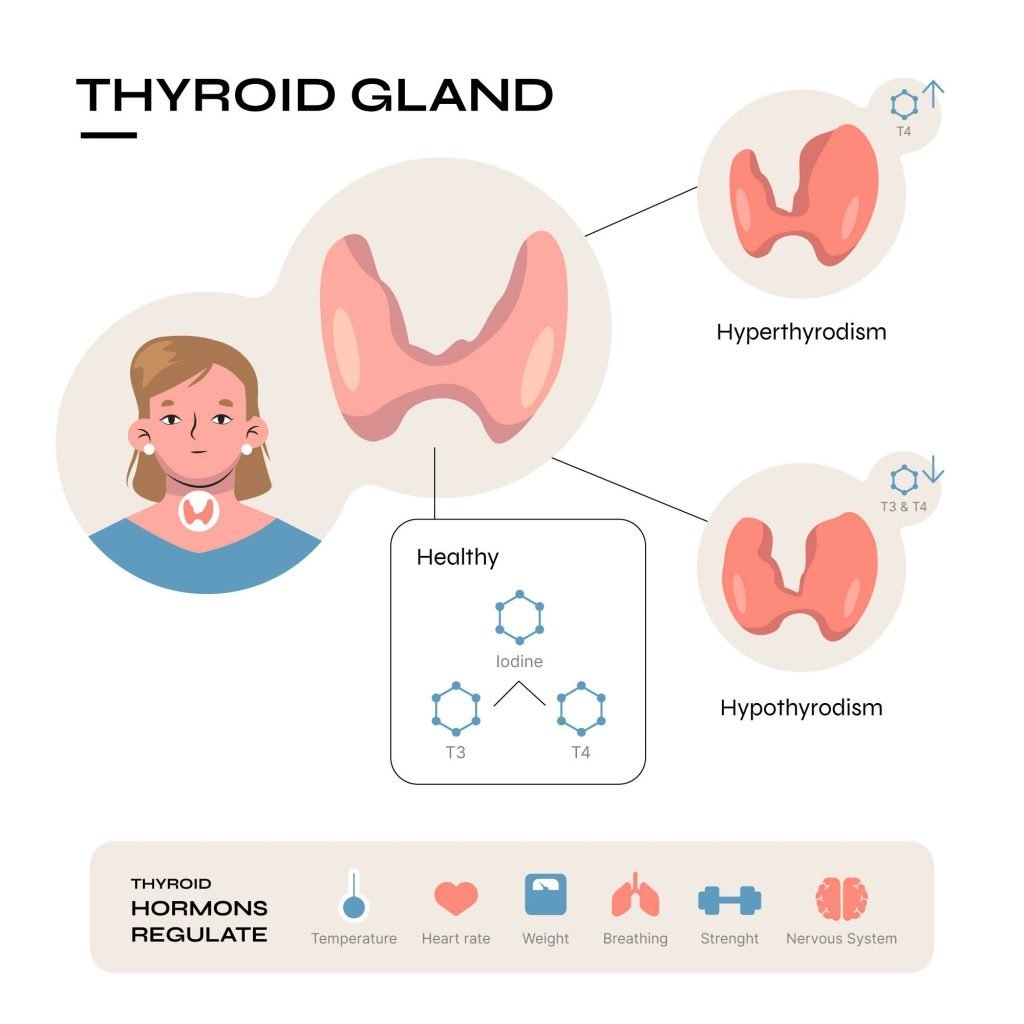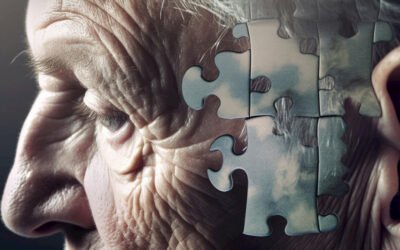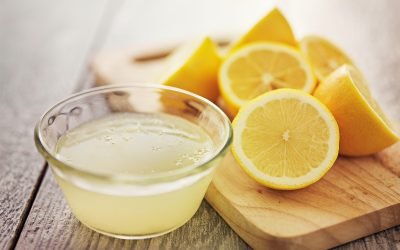The thyroid gland, a small structure normally weighing only one ounce, has a disproportionately immense influence on the human organism. Hypothyroidism (underactive thyroid) is so prevalent in this era that symptoms of nearly every chronic disease are, to varying degrees, linked to abnormal thyroid activity.
Located in front of the trachea, just below the larynx on either side, the thyroid gland produces several hormones, including thyroxin (T3) and triiodothyronine (T4) which help to regulate the metabolism of carbohydrates, mobilization of fats and synthesis of proteins. Calcitonin, another hormone secreted by the thyroid gland, helps to regulate calcium and phosphate levels and is required for uptake of calcium by the bones.
Normal thyroid function is required for virtually every bodily activity. T3 and T4 hormones increase: cellular absorption of glucose; pancreatic secretion of insulin; depth and rate of respiration; secretion of digestive enzymes; peristaltic motion of the gastrointestinal tract. T3 and T4 also help to regulate heartbeat and blood pressure, sex hormone output and emotional balance.

In 1899, Dr. Eugene Hertoghe established the relationship between thyroid deficiency and many female disorders. Hypothyroid women are frequently found to have inadequate levels of the follicle-stimulating hormone (FSH): a thyroid-modulated hormone that initiates maturation of the egg cells in the ovaries. The developing egg cells, in turn, produce estrogen. Hypothyroidism most often results in painful menorrhagia (excessive blood-flow during menses occurring at irregular intervals). Amenorrhea (absence of blood-flow) is a less frequent result. Notably, menopausal hot flashes are sometimes attributable to hypothyroidism.
Broda Barnes, M.D., an authority on the treatment of thyroid disorders, asserts that hypothyroidism and hypoglycemia (low blood sugar) are closely related disorders. He reasons that low thyroid function causes sluggish liver function. One of the liver’s jobs is to convert glycogen into glucose when blood sugar needs to be elevated. Weakened adrenal glands have also been implicated in chronic hypoglycemia. Some studies suggest that hypothyroidism causes the adrenal glands to shrink. Notably, hypothyroidism may also play a significant role in diabetes, i.e., hyperglycemia or high blood sugar.
Symptoms of Hypothyroidism
Physical symptoms: low energy levels; chronic fatigue; hypersensitivity; chilliness; cold hands and/or feet; fluid retention; hypoglycemia or diabetes; slow wound healing; mental dullness and failing memory; insomnia; unrefreshing sleep; weakened immune system; puffy face and eyelids; devitalized hair, skin and nails; heart palpitations; digestive weakness; poor appetite; constipation; inability to tan; excessive and painful menstruation; absence of period; menopausal hot flashes; infertility and deficient breast development; loss of bone mass; muscle soreness; neuralgia; joint pain.
Emotional symptoms: anxiety; nervousness; depression (including post-partum depression); despair about recovery from illness; indifference to everything; irritability; suspiciousness; temper tantrums; introversion; delusion of being persecuted; angered when contradicted; scolding; rage over trifles; quarrels with family; euphoria alternating with quarreling.
Supporting the Thyroid Gland Using Vital Chi Skin-Brushing, Hydrotherapy and Essential Oils
One of the primary laws of traditional naturopathy is: Local diseases are expressions of general states. As hypothyroidism is a localized deficiency that is a product of systemic depletion, the best way to resolve it is via an integrated protocol of thyroid-specific, whole-body therapeutic measures. This article focuses upon three synergistic, whole-body therapies that can help revitalize the nervous, circulatory and glandular systems. This three-system interface is crucial as optimal glandular function depends upon robust blood flow and nerve transmission.
Vital Chi Skin-Brushing System
Vital Chi Skin-Brushing can sustain or reestablish the skin’s functional integrity and youthful glow. The skin is as major an organ as the heart, lungs and kidneys. Its primary functions include: respiration, excretion, blood and lymph circulation, immunity and the conduction of chi. However, unlike other vital organs, the skin can be non-invasively accessed and mediate systemic rejuvenation by a variety of therapeutic techniques, including proper skin-brushing. Thus, Vital Chi Skin-Brushing is a particularly powerful therapy which can positively impact the entire body.
Variations of skin-brushing have been practiced for thousands of years. For many centuries, the Japanese employed vigorous skin-brushing with loofa sponges as a prelude to their traditional hot bath. Prior to bathing (following a hard training session or physical competition) ancient Greek athletes used strigiles: specialized spoon-like skin scrapers to remove the grime of exertion and encourage circulation. Among the Cherokee Indians, skin-brushing with dried corn cobs to enhance skin beauty and durability was once a traditional practice. The Comanche Indians scrubbed their skin using sand from the Texas river bottoms, and the Texas Rangers followed their example.
Adolph Just in his Nature-Cure classic: Back To Nature tells that he learned the importance of skin-rubbing by observing wild animals: “Higher land animals, especially wild boars and deer, in free nature, are in the habit of lying down in small muddy swamps and pools and rubbing to and fro in the mud. After awhile they rub themselves against the earth, trees and other objects. The birds go to brooks or springs, and, by immersing their necks, throw water over their bodies…then they rub or scrub the body using their head, bill and wing elbows.”
My Vital Chi Skin-Brushing System, which required hundreds of hours of research and experimentation to develop, evolved from my training and teaching experience in anatomy and physiology and various bodywork disciplines as well as the Oriental healing arts. I designed this system to support blood- and lymph circulation, the immune system, the movement of chi along the acupuncture channels, all the major physiological functions of the skin as well as to enhance skin beauty and encourage the breakdown of cellulite. Yet, my system is quick, concise and user-friendly.
Primary Benefits of the Vital Chi Skin-Brushing System:
Assists Exfoliation:
The outermost layer of skin cells which serve to protect the underlying skin layers are not living cells, thus, they are continuously shed and replaced via the multiplication and upward movement of living skin cells. Inactive aging skin does not shed dead cells as easily as does youthful skin, so it is susceptible to cellular build-up which accounts, in part, for the dry, thick, leathery-look of older skin. The most obvious mechanical effect of skin-brushing is the detachment of dead skin cells.
Excites Physiological Functions:
Proper skin-brushing supports lymphatic drainage of the skin by:
- accelerating filtration from the intercellular spaces into the lymph vessels;
- the emptying of the smaller vessels into the larger lymph vessels;
- assisting the flow of lymph through the lymph nodes.
The lymph vessels transport excess, waste-charged fluid away from the intercellular spaces and return it to the bloodstream. Lymph acts as a go-between medium for the transfer of vital materials from the blood to the cells, and for cellular debris away from the intercellular environment into the blood. Thus, the blood feeds the lymph, and the lymph feeds the cells, making the drainage of intercellular lymph one of the most crucial of all bodily functions. The superficial lymph vessels terminate just below the outer layer of skin and interjoin freely with the deeper lymphatic vessels. Any blockage at the superficial lymphatic level will result in congestion throughout the whole lymphatic system. Skin-brushing is an excellent way to stimulate the activity of the entire lymphatic system.
Skin-brushing similarly increases venous blood flow. The veins carry the blood back to the heart. Return blood-flow through the veins is not propelled as much by direct heart action as by muscular contraction and vein constriction. Skin-brushing excites and tonifies the muscles and nerves of the skin, thus, it improves venous circulation. These same mechanical effects directly enhance capillary circulation as evidenced by the skin-flush and feeling of warmth that skin-brushing imparts.
The skin is impregnated with nerve end-fibers which play an indispensable role in nervous system activity. This explains the remarkable relaxing effect, including decreased muscular tension, elicited by skin-brushing. Decreased muscular tension affords better lung capacity, digestion, bowel movements, blood circulation, lymph drainage as well as clearer thinking.
Strengthens the Bioenergy System:
“Aliveness” derives from the presence of high-vibratory, vital energy within an organism. This energy, or natural force, which fills the universe is referred to in traditional naturopathy and homeopathy as vital force and in Chinese medicine as chi. Hence, I have coined the term Vital Chi.
Chi is the fundamental energy which sustains life and is present in the vibratory, biological processes of every cell. Chi is not synonymous with the metabolically generated energy derived from the oxidation of glucose. Rather, it is the force that animates the metabolic processes which ultimately yield caloric energy. Chi differentiates life from death; it circulates through channels, or meridians, throughout the body. Unimpeded chi-flow is essential to the prevention and cure of disease. Since the chi meridians course through the skin, they are readily accessible to the ministrations of skin-brushing. When these channels are properly massaged, the movement of energy along their length is stimulated and the delivery of chi to their associated organs greatly improved.
Benefits Mature Skin:
Decreased sweat- and oil gland functions are features of aging. The oil secreted by the sebaceous glands coats the surface of the skin and prevents excessive water-loss through evaporation. Proper skin-brushing stimulates both the sweat and oil glands, and in this way, contributes to the restoration of moist, supple skin. Also, it strengthens the skin pores through which the skin is moisturized and cleansed, and oxygen and CO2 are exchanged. Aging and devitalization of the skin often results in pore-enlargement and flaccidity due to loss of skin tone.
Promotes Skin Beauty:
Skin-brushing makes a strong impression upon the dermis (the skin layer that contains an abundance of blood and lymph vessels), nerves, glands and elastin and collagen fibers. The dermis provides nutrients and moisture to all the skin layers and lends contour and flexibility. When the dermis ages, its connective tissue fibers reduce, rigidify, lose resilience and even break into pieces, causing the skin’s support muscles to lose tone and volume and the skin to dehydrate and collapse into sags, wrinkles and lines.
Healthy connective tissue and muscles are products of efficient nutrient support and oxygenation, a waste-free milieu, optimal water balance and moderate exercise, all of which are promoted by regular skin-brushing. The gentle stretching of connective tissues, afforded by proper skin-brushing, helps to increase and regenerate the production of collagen and elastin fibers.
Cellulite is a structural disturbance of fat tissue. The fat content of cellulite-containing tissue is normal, but fibrous nodules surrounding the fat cells give affected skin areas their typical orange-peel appearance. Cellulite formation is related, in part, to local vein and lymph congestion. Proper skin-brushing can help to alleviate this condition.
Vital Chi Skin-Brushing System: Selected Guidelines And Selected Technique
(Excerpted from Dr. Berkowsky’s Vital Chi Skin-Brushing System book)
Selected Guidelines
- Always treat the major lymph gland drainage site of a given body region before brushing said region, thus allowing for more effective regional lymphatic clearance. For instance: brush armpit (site of axillary nodes which drain chest) before brushing chest.
- The body should be brushed in a strategic sequential pattern to allow for maximum drainage. For instance: because the neck and head drains into the venous system in the upper chest, and to a small extent, into the axillary nodes, the chest and armpit regions should be brushed before neck and head regions.
- Brush-stroke direction always conforms to the route of lymphatic drainage. Example: The chest region drains into the armpit. Hence, the chest on each side is brushed from breastbone to armpit.
The Vital Chi Skin-Brushing System addresses the entire skin surface (with the exception of the breasts and genitals). The following excerpt from my book focuses on the chest region.

Brush Chest Region as follows:
Above Breast (See Picture): Brush 7 times each side of chest from breastbone to armpit.
Note: The two major lymphatic ducts empty into the venous system in the left and right chest just below the collar bone. Puffiness above or below the collarbone is indicative of congestion in these ducts. Reducing lymphatic tension in the chest enhances tissue drainage of the entire body.
Below Breast (See Picture): Using upward curving stroke (under breast), brush 7 times on each side from sternum to armpit.Sides of Upper Torso (See Picture): Brush upward 7 times along each side (in line with the armpit), from waist up to armpit.
Follow-Up Hydrotherapy: The Alternate Hot/Cold Shower
Having studied and practiced traditional naturopathy for more than 25-years, I have come to appreciate the great value of many of naturopathic hydrotherapies and their particular synergy with my dry skin-brushing system. Hence, I instruct that a skin-brushing session should always be followed by an appropriate hydrotherapy. The Alternate Hot/Cold Shower is one of the primary hydrotherapies to consider for revitalization of the thyroid gland.
Hot and cold water can be used in alternation to prolong the initial tonic-stimulant effect of hot water. In the case of the Alternate Hot/Cold Shower, the hot shower is applied first for 2- to 3-minutes; then, instantly, before the sedative reaction of prolonged heat can take place, a 15- to 20-seconds short, cold shower, is taken (while hand-rubbing the skin throughout this cold-water shower to increase circulation).
Next, a second hot shower is used (as above), and the body responds with new vigor to the tonic-stimulant effect of the hot water. Always finish with cold water (as above) to ensure that the important warming reaction takes place. This procedure is referred to as contrast treatment during which the heat magnifies the stimulating effect of the cold, and vice versa, providing a powerful gymnastics workout for the blood and lymph systems.
Remember, the greater the temperature differences between hot and cold applications, the greater the effect. Importantly, for maximum personal benefit, the contrast between the two temperature extremes should be to the limits of comfortable tolerance. One should not be heroic and overtax the system. Be conscious of your relative state of vitality on a given day and adjust the temperature of the water and duration of each shower phase accordingly. Also, if assisting another person, let that person be the judge of comfortable water temperature.
Two to three alternations (no more) between hot and cold water are used. The first contrast cycle is always the most intense. The following ones are less so since the body’s ability to react progressively declines. Thus, excess (more than three) hot and cold alternations may be depleting and defeat the treatment’s purpose.
Of all the various hydrotherapies, this “unequal periods” Alternate Hot/Cold Shower procedure is one I recommend most commonly as an overall tonic treatment to revitalize circulatory, endocrine, immune, lymphatic, nerve and skin functions. The Alternate Hot/Cold Shower (preceded by the Vital Chi Skin-Brushing routine) employed three to four times weekly has proven to be wonderfully restorative.
Follow-Up Lemon Juice/Essential Oil Rub
After your Alternate Hot/Cold Shower while the skin is still moist, you might perform a powerfully synergistic lemon juice/essential oil rub-down.
Preparation: Squeeze the juice of half a lemon (preferably organically grown) into a small cup. Add to the juice, 4 to 5 drops of one or more of the essential oils listed below. whether using one or more oils, the total amount of oil added to the lemon juice should not exceed 5 drops. Next, stir with a wooden toothpick. Then, using your bare hands, rub the mixture into the moist skin until completely absorbed.
Essential Oils and Their Relevant Properties
Note: Listed here are only those properties of the following oils which are most relevant regarding the thyroid gland. The description of each oil is organized as follows: 1) general properties; 2) specific symptoms or disorders. The symptoms are listed in the following order: mental, general, head, throat, chest, abdominal, pelvic, musculo-skeletal, and skin.
Bitter orange (Citrus aurantium) – balances nervous system; promotes good circulation, warms the body; mood elevating; harmonizes mind, body and spirit. It is considered potentially useful for: nervousness; anxiety; insomnia; confusion; boredom; negativity; depression; moodiness; irritability; selfishness; stubbornness; addiction (especially alcohol addiction); malaise; sympathetic nervous system weakness; anterior pituitary insufficiency; chilliness; heart palpitations; hypoglycemia; nervous stomach; irritable bowel syndrome; adrenal insufficiency; sore muscles.
Black spruce (Picea mariana) – endocrine tonic; (especially thyroid, pituitary, adrenal and pituitary-ovarian axis); nerve and respiratory tonic; stimulates thymus gland; strengthens circulation; benefits prostate gland; counteracts debility and exhaustion; grounding and uplifting. It is considered potentially useful for: anxiety; nervous tension; fatigue; exhaustion; debility; immunological weakness; tendency to infection; muscular and nerve pains; rheumatism; arthritis; water-retention with tissue laxity.
Eucalyptus (Eucalyptus globulus) – specific for the thyroid gland; clears head congestion; strengthens circulation; immune stimulant; nerve tonic; counteracts tendency toward low blood sugar; general tonic; counteracts debility and mental sluggishness; aids concentration. It is considered potentially useful for: melancholy; feeling of stagnation; exhaustion; nerve weakness; unable to do mental work; no desire for any motion; diabetes; hypoglycemia; rheumatic pain; indolent wounds and ulcers.
Pine (Pinus sylvestris) – purifies and tonifies the emotions; stimulates, purifies and tonifies respiratory tract; warming, circulatory tonic; immune stimulant; general tonic; supports thyroid gland, adrenal glands and pituitary-thyroid-gonad axis; sexual restorative; lymphatic decongestant; reduces fatigue and debility; lymphatic decongestant. It is considered potentially useful for: poor circulation; chilliness; water retention; fever with chills; fatigue; nervous exhaustion; general debility; diabetes; impotence; musculoskeletal pain; cold feet.
Spikenard (Nardostachys jatamansi) – balances heart action, hypothalamus and autonomic nervous system; eases indigestion; encourages balance among mind, body and spirit; enhancesacceptance, compassion, devotion, humility, generosity, inner balance and inner peace. It is considered potentially useful for: insomnia; nervous stress; anxiety; restlessness; despondency; resentment; spiritual uncertainty; emotional wounds; tachycardia (rapid heartbeat sometimes due to nervousness and anxiety); cardiac pain of nervous origin; nervous indigestion.
Important Note: This article is for informational purposes only and is not meant as a prescription. Each person is unique and advised to seek the advice of a qualified health-care practitioner to determine relevance in a given case. Never skin-brush during an active metastatic cancer state. Cancer patients are advised to consult on oncologist if considering a skin-brushing regimen.






